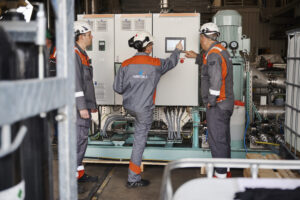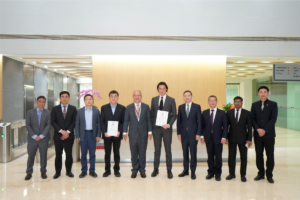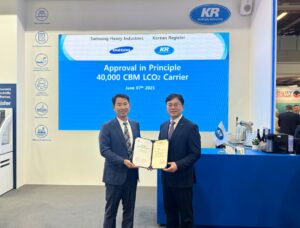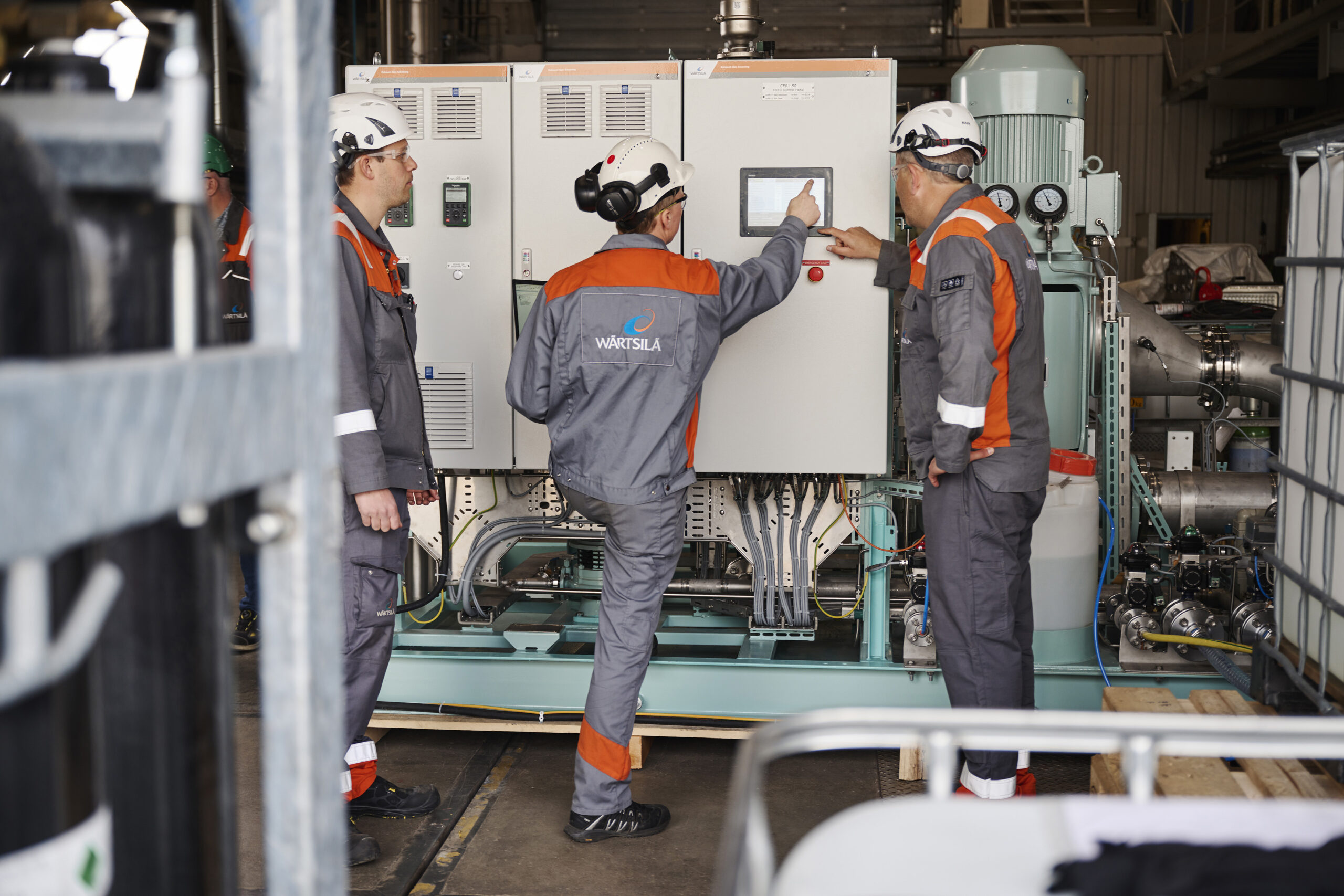
Carbon capture, new fuels and energy efficiency are the path to net zero says latest ABS research

Value Group welcomes Shell Ventures as investor to accelerate marine decarbonisation

Wärtsilä offers onboard carbon capture and storage feasibility studies

Value Maritime launches sister company Value Carbon to handle all shore-based carbon activities

Carbon capture project by Wah Kwong and Qiyao Environ Tec receives Approval in Principle

KR grants Approval in Principle (AIP) to SHI’s LCO2 carrier
Show transcript
Kazuki Saiki
It’s like a scrubber, a SOx scrubber and you create a shower of the amine solution through the exhaust gas and through this physical contact between the water solution and the gas, the amine will catch the CO2 out of exhaust gas.
Sigurd Jenssen
We have different constraints on when you’re putting something on a ship compared to land or land you can build a tower that’s 30 metres high. You can do that on a on a ship.
Craig Eason
Hello there! You’ve probably heard about the technology known as carbon capture, industrial CO2 emissions are caught compressed and then either sequestered somewhere that they can’t escape from, like an old underground hydrocarbon reservoir, or possibly reused in chemical or even potentially electrofuel production. It’s a growing sector and one that the International Energy Agency says will be key to society meetings, decarbonisation goals, so there will be a significant demand for CO2 shipments if their predictions are accurate. Now while carbon capture plants are huge, there is now work underway to see if the systems can be reduced in size, and then installed on ships to capture some of their CO2 emissions. This is the Aronnax show, a podcast about the technology and sustainability of the shipping maritime and ocean space. I’m Craig Eason, owner of the Fathom World News and Information site. And in this episode of the podcast, we’re looking at how to take a complex large industrial technology and Maranise it for shipboard use. CO2 capture is an established set of technologies in some industries. Although the different ways the CO2 is captured varies depending on the industry It is currently used for. The issue with scaling a CO2 extraction solution for a ship is cost efficiency and space on board. I know of three companies currently researching this to see if it may work though. There may be other companies too that I don’t know about. The ones I know well that Centre in Norway, TECHO 2030 in Norway and Mitsubishi shipbuilding in Japan. None of them know yet whether it will fully work. But the success of marinising sulphur dioxide scrubbing technology and enabling ships to meet the sulphur emission regulations points to the potential. There are a number of different processes for capturing CO2 from industrial emissions, but one employs a similar method to the scrubber technology namely that a liquid is sprayed through the exhaust to capture the specific pollutant and then that liquid is subsequently cleaned. As Siggurd Jenssen at Wärtsilä told me recently,
Sigurd Jenssen
The last few years we have been very busy with delivering scrubber projects, but we have also then come to the realisation that carbon capture technology has matured. So we have been around to various land based facilities and talk to various people who are dealing with carbon capture on the land. And our conclusion from all of this is that the technology is sufficiently mature to start bringing this on to ships as well. We have looked at different technologies, be it sort of solvent based scrubbing, membrane separation or cryogenic separation, and we think there are key elements in all of these technologies. But But initially, we will focus on a solvent-based scrubbing process, in part because that’s where most of the experience is on land. And also because we think we know a thing or two about scrubbing. We see that there are opportunities for us to take that land based technology and convert it to to a ship. We have different constraints, when you’re putting something on the ship compared to to land. On land, you can build a tower that’s 30 metres high, you can’t do that on a ship. But, based on the experience that we have with with SOx scrubbers and the know-how that we have around the scrubbing technologies, we we see that we can make it a little bit more compact, and more fit for use on the ships. So that is what we’re going to do now; instal test unit of one megawatt size in in our lab, it will still be land-based but it will mimic a marine installation with both SOx scrubbers and we have SCRs and we have a small auxiliary engine running on HFO. So we can really get as close to being on the ship as as possible. and then we need to spend the next year or years playing around with the with a parameter, seeing what trade-offs we can make in making this fit, for shipboard installation,
Craig Eason
Jenssen said that the technology the vatsal that we’ll be looking at will use chemicals known as Amines on a ship, the amines are an ammonia derivative and they’re sprayed through the exhaust to catch the CO2. And it is very similar process that Mitsubishi Shipbuilding is also looking at.
Kazuki Saiki
My name is Kazuki Saiki. I am from our strategic planning and operation office, of Mitsubishi Shipbuilding. I used to be an engineer, and I was doing the initial designs of, let’s say, feeder LNG vessels or LNG bunkering vessels. Back then I was designing container ships and so on, but last year, I was project manager of this CC Ocean project. This all conversations and discussions over alternative fuels, zero emissions and carbon capturing started back in 2018, where IMO decided this very ambitious goal for IMO 2050, where we all have to cut off 50% of entire greenhouse gases from maritime sector. So this is why we have started discussing over alternative fuels such as hydrogen, ammonia, and synthetic fuels, biofuels. These have to be carbon neutral and along with that, we have an option of carbon capturing on board. What really differentiates carbon capturing from the other alternative fuels is that it’s a combination of feasible technology from land based industry. It is not that we are committed for onboard carbon capturing we are also developing ammonia fuel fuel gas supply system. And also we’re working on electrification of smaller ships. But we do believe there will be a worldwide CO2 supply chain, and so we think that this will be an option.
Craig Eason
The CC Ocean project that Mitsubishi is running is on a K Line vessel or will be on a key line vessel on international trade in the Pacific Ocean. The project is being funded by the Japanese government and as well as Mitsubishi and K line, Class NK, the Japanese class society is also involved.
Kazuki Saiki
First of all, I have to confess that we’re only collecting 0.1 tonne per day of CO2. So, this is just like 0.1% of entire emissions from the ship. And we only have carbon capturing plant, meaning that we don’t have liquefaction plant or storage tanks. So, regretfully, we have to return the captured of CO2 back to the exhaust gas. So, why are we doing this is that we want to confirm even though this is a proven technology, there are the requirements from Marine use And we wanted to confirm the effect of marine environment to the performance of the carbon capturing. The effects that were concerning is including the ship motion, and also the the sulphur content. We know that the sulphur content in exhaust gas will deteriorate the performance of amine, and the third one is we need to confirm safe operation by crew. So, these are the main purposes that we want to confirm through this trial. This year
Craig Eason
Kazuki said to the development of onboard CCU will develop after the market for co2 carriers and shipments of CO2 grows something the IAEA says will need to happen if the world is to reduce its greenhouse gas emissions sufficiently to meet its targets.
Kazuki Saiki
We are very much aware that there has to be a port infrastructure, to accept the captured CO2 from the sea. But we’re being pretty much optimistic about it because the on the land, oil and gas industry there are more and more needs for CCS and carbon capture and storage or er, enhanced oil recovery. And we are also getting many, many inquiries on liquefied CO2 carrier. So this is another story it’s not about the onboard carbon capturing, but simply carrying the the liquefied CO2 and this need is coming from CCS. So, we do believe that there will be a seaborne CO2 supply chain. So, what I am guessing is that the carbon capturing onboard will come after the building of this seaborne CO2 supply chain. So in light, that means we can just utilise the port infrastructure structure and we don’t have to worry about what happens after bringing back to the poor
Craig Eason
Neither Mitsubishi nor Wärtsilä have been able to put a date on when shipping would be able to buy and instal tested, approved, and economically viable systems. But given the investment both companies are making, they are obviously confident that there would be demand should it work. The main target would be the existing fleet of vessels as own as eye the requirements that they will need to meet for the 2030 emission goals being laid out by the IMO. But this also relies on the IMO having taken into account carbon capture technology as a viable and equivalent emission reduction technology. The member states are currently finalising the requirements for the energy efficiency existing ship index and the carbon intensity indicator. These are the two regulatory tools to be used to get owners to improve individual ship efficiency. But there isn’t any scope at the moment for this abatement technology and the calculations. And for carbon capture on board to work owners really do need to feel confident of the CCU technology and its ability to help them meet the regulatory requirements.
Sigurd Jenssen
On land, they are looking at capture rates in the high 90s. They’re they’re researching how to go from 99 to 99.5%. capture it, that’s not what we are looking for in in shipping, we need to reduce the overall greenhouse gas emissions and if we can take out 70%. I mean, that is a huge step, and that aligns with the IMO targets as well. So I think that is our starting point that we know that we were able to do quite a lot of good, we’re not going to get to 100%, at least not in the in the near future. Eventually, that might be a possibility, but doing 70% now is going to do a lot of good. It’s not without its challenges. wouldn’t be any fun otherwise. And for sure, there will be sacrifices that needs to be made. You will need to add a scrubber,and a stripper, and cooling and compression plant and not least the storage aspect. So you won’t lose something in terms of space or cargo capacity. But we think that is a relatively minor compromise for the benefit that you would, would get. And to be fair, if you look at the the alternatives, there are compromises that have to be made for those as well. So it’s this or that.
Craig Eason
So before we end before you go a request. If you can share, subscribe, and like this podcast. I put the show together in my own time because I’ve got a great interest in what’s going on in the ocean industries. And if you have got to this part of the show, then you obviously do too. So get in touch if you want to talk to me about your ideas, and until the next time, goodbye.
































